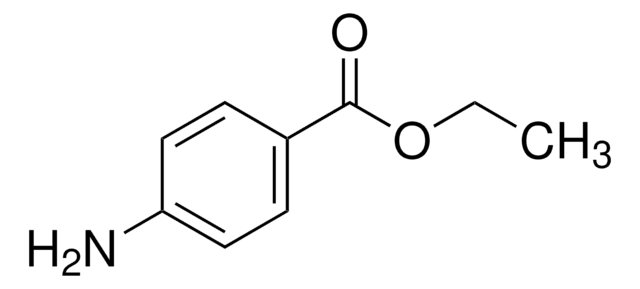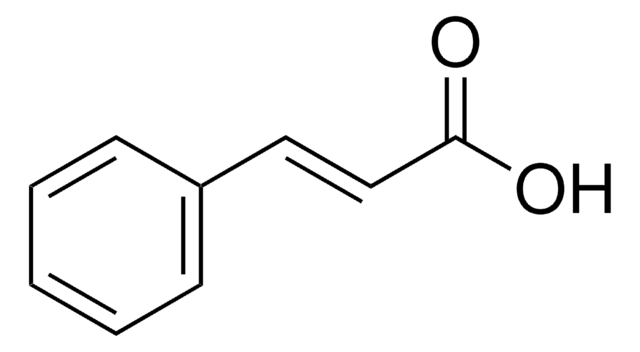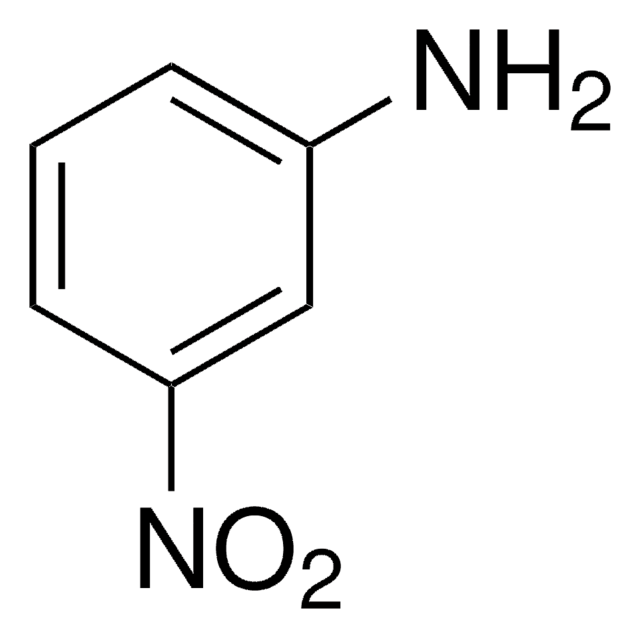Kluczowe dokumenty
76170
Melting point standard 121-123°C
analytical standard
Synonim(y):
Benzoic acid
About This Item
Polecane produkty
klasa czystości
analytical standard
Poziom jakości
gęstość pary
4.21 (vs air)
ciśnienie pary
10 mmHg ( 132 °C)
temp. samozapłonu
1061 °F
okres trwałości
limited shelf life, expiry date on the label
bp
249 °C (lit.)
mp
121-123 °C (±0.3°C)
121-125 °C (lit.)
Zastosowanie
food and beverages
pharmaceutical
Format
neat
ciąg SMILES
OC(=O)c1ccccc1
InChI
1S/C7H6O2/c8-7(9)6-4-2-1-3-5-6/h1-5H,(H,8,9)
Klucz InChI
WPYMKLBDIGXBTP-UHFFFAOYSA-N
Szukasz podobnych produktów? Odwiedź Przewodnik dotyczący porównywania produktów
Powiązane kategorie
Opis ogólny
Zastosowanie
Cechy i korzyści
- Melting point calibration standard traceable to primary standards (LGC, London)
- Grade: Analytical Standard
- Uncertainty of measurement up to ± 0.3 °C
- Provided with certificates of analysis and safety data sheet
- A product of analytical standard grade that meets the QC/QA requirements of melting point analysis
Hasło ostrzegawcze
Danger
Zwroty wskazujące rodzaj zagrożenia
Zwroty wskazujące środki ostrożności
Klasyfikacja zagrożeń
Eye Dam. 1 - Skin Irrit. 2 - STOT RE 1 Inhalation
Organy docelowe
Lungs
Kod klasy składowania
6.1C - Combustible acute toxic Cat.3 / toxic compounds or compounds which causing chronic effects
Klasa zagrożenia wodnego (WGK)
WGK 1
Temperatura zapłonu (°F)
Not applicable
Temperatura zapłonu (°C)
Not applicable
Środki ochrony indywidualnej
dust mask type N95 (US), Eyeshields, Faceshields, Gloves
Wybierz jedną z najnowszych wersji:
Masz już ten produkt?
Dokumenty związane z niedawno zakupionymi produktami zostały zamieszczone w Bibliotece dokumentów.
Klienci oglądali również te produkty
Produkty
HPLC Analysis of Benzoic Acid and Sorbic Acid on Ascentis® Express RP-Amide ("Green" Mobile Phase Conditions)
Separation of Acetaminophen, meets USP testing specifications, 98.0-102.0%, powder; Caffeine, meets USP testing specifications, anhydrous; Benzoic acid, meets USP testing specifications; Aspirin, meets USP testing specifications
Protokoły
Separation of 4-Hydroxybenzoic acid; Acetylsalicylic acid; Benzoic acid; Salicylic acid; Ethyl 4-hydroxybenzoate
HPLC Analysis of Benzoic Acid Derivatives on Ascentis® C18
Nasz zespół naukowców ma doświadczenie we wszystkich obszarach badań, w tym w naukach przyrodniczych, materiałoznawstwie, syntezie chemicznej, chromatografii, analityce i wielu innych dziedzinach.
Skontaktuj się z zespołem ds. pomocy technicznej










